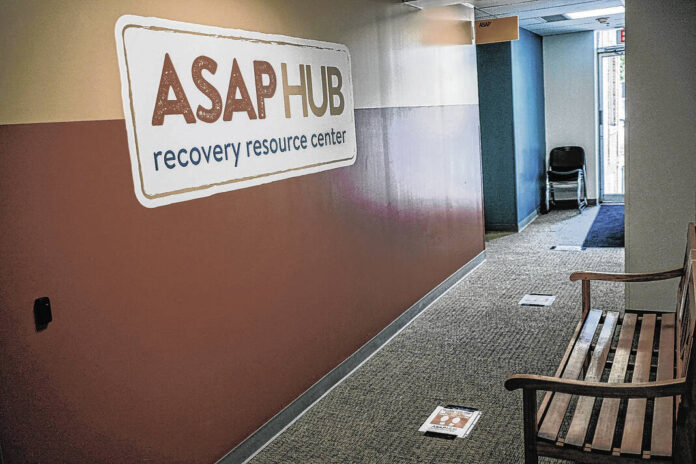
Mike Wolanin | The Republic A view of the hallway leading to the entrance of the Alliance for Substance Abuse Progress Bartholomew County Hub in Columbus, Ind., Monday, June 15, 2020.
A multi-disciplinary group is expected to start reviewing local overdose deaths and suicides this week as part of an effort to identify data-informed initiatives that officials hope will prevent future deaths.
The group, called the Bartholomew County Suicide and Overdose Fatality Review (SOFR) Team, is scheduled to meet Friday at the United Way offices in Columbus, where members will start to review fatal overdoses and suicides for the first time, officials said.
The team was formed late last year as local overdose deaths soared to their highest level on record and includes representatives from the Alliance for Substance Abuse Progress (ASAP), Bartholomew County Coroner’s Office, Columbus Regional Health, Centerstone, among more from other organizations.
Prior to the meeting, team members will be gathering as much information as possible about the individuals who have died whose cases will be part of the review.
“They will bring information from their organizations about that person — if they have some — and it will be reviewed as a group, and we’ll look for opportunities to intervene that there may have been,” said Sherri Jewett, executive director of ASAP. “Our goal here is to identify trends and patterns that we as a community can address to try to address the number of suicides and overdoses.”
Currently, it is hard to say if or when any patterns or trends will emerge, though officials said they expect that it will take at least several months.
Officials have said that they hope to identify consistent risk factors and opportunities for intervention to develop an action plan to address any gaps that may exist in local prevention efforts.
Bartholomew County Coroner Clayton Nolting previously said that his office will make its resources, analytics and data available to the review team.
Jewett said that officials have been working with the Indiana Department of Health to set up the review team.
More than 20 counties in Indiana now have SOFR teams, according to the Indiana Department of Health.
The team’s first meeting comes a couple weeks after a report from the Bartholomew County Coroner’s Office showed that drug overdose deaths soared to 39 last year — the highest annual total on record.
The most common drug involved in overdose deaths last year was fentanyl, which was detected in 27 of the 39 deaths, the report states. Animal tranquilizer xylazine was detected in one overdose death in 2022, though that death also involved fentanyl.
Officials have largely attributed the historic rise in overdose deaths in the county to the increasing presence of fentanyl, a synthetic opioid that is more potent than heroin that officials say is increasingly being mixed with other drugs.
Overdose deaths have risen nearly seven-fold since 2015, setting records for three consecutive years, local records show. There were 33 fatal overdoses in 2021, up from six in 2015.
However, most overdose deaths involve multiple substances, Nolting said.
Last year, suicides declined to their lowest level since at least 2015, with six recorded in the county, according to the report. By comparison, suicides had hovered between 11 and 16 in each of the previous five years.
All but one of the suicides last year involved a firearm, the report states.
Jewett said earlier that “almost always, there’s some type of substance use at the time of suicide.”
As officials prepare for the team’s first meeting, they remain hopeful that their comprehensive approach will help prevent future deaths.
“It’s broad, but that’s the whole intention,” Jewett said, referring to the scope of the team. “You want as many different community organizations (as possible) that might have provided services or support or might have had interactions with the person to present their information and what they saw. The goal is to really to see a comprehensive perspective of that person and to identify where we might have been able to do more.”




